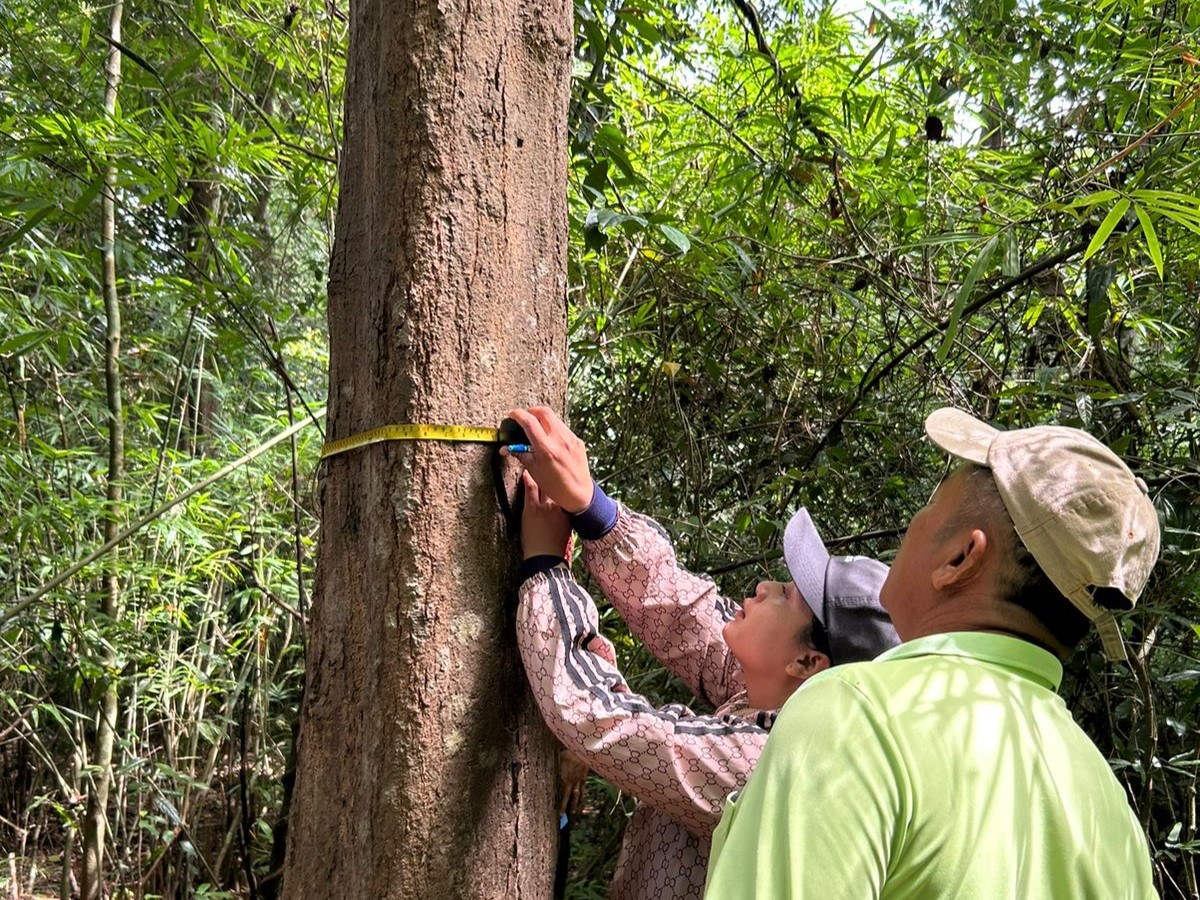Communities unite to preserve forests

Participants measure trees in protected forest. Credit - Thidthixay Phommavong.
Remote forest-fringing villages in Laos are spearheading a pioneering project that is striving to enhance biodiversity and improve livelihoods
“Hello, my name is Ms. Faimanee, I am 55 years old, currently living in Nakok Village, Mahaxay District, Khammouane Province in Laos. My family and I started participating in the project in August 2024. We received support to build a village tree nursery. The village nursery is a learning place for the entire village. The village nursery is 10 x 10 m in size. The project's technical staff and staff from the Agriculture Office have trained us in theory and practice on growing seedlings from nature that we find ourselves. It made me and the others in our Farmers' Club very interested because it is the first activity in the village that received funding to build a nursery from a project. Throughout my participation in the nursery activity, I learned many methods such as establishing a nursery, mixing fertilisers, and maintaining the nursery plants. In addition, I also use it in my family garden. In short, the work with this nursery has made our Farmers’ Club group more united. It was clear when the project came to lead the implementation of activities in the seedling nursery. I will bring the lessons learned from the project to the other people in the village.”
Throughout my participation in the nursery activity, I learned many methods such as establishing a nursery, mixing fertilisers, and maintaining the nursery plants."
Ms. Faimanee is 1 of 600 farmers participating in the project to tackle poverty and biodiversity loss for sustainable development. She was empowered by the opportunity to participate in developing and building the nursery and used her experience and passion to include other village members.
The project addresses deforestation and rural poverty across the Khounkham, Gnommalath, and Mahaxay Districts, Khammouane Province, Laos. It directly targets 3,300 people in 12 remote villages adjacent to protected forests promoting improved livelihoods that simultaneously foster forest and biodiversity conservation.
The area is home to numerous endangered species in the Indo-Burma Hotspot for biodiversity and is located within the upper valleys of the Mekong River catchment. The rugged woodlands of the Annamite Mountains' limestone karst hills limit communities' access to arable land and the rural communities in the target area suffer from widespread poverty. Lao Biodiversity Association and Humana People to People Laos work together to implement the project to encourage the 600 participating farmers to protect the sustainable use of biological resources, which combined with conservation agriculture approaches, contributes to alleviating poverty. The project works through community-based organisations (Farmers’ Clubs), strengthening the village's social capital, reinforcing general resilience, and guaranteeing long-term sustainability of the results.
The project started in August 2024, and part of the first activities was to survey the level of biodiversity in the protected forest areas close to each of the 12 focus villages. The Village Chiefs were invited to participate in the survey with the District Agriculture and Forestry Office (DAFO). These leaders were very interested to get more knowledge about the forest and advises about how to use it sustainably. They are pivotal in mobilising the families in the villages. Lao Biodiversity Association was leading the survey. They shared their profound knowledge about the forest and biodiversity, and gave thorough explanations and encouraging speeches about the importance of biodiversity. The participants marked 60 plots of 50 x 50 m, 5 per village, and noted all the plants, measured the trees, and collected the information to be analysed. Lao Biodiversity Association will finish a report on the survey to be shared with the villagers, and it will form a cornerstone for the project's results in the future.
 Marking plots to be surveyed in protected forest. Credit - Thidthixay Phommavong.
Marking plots to be surveyed in protected forest. Credit - Thidthixay Phommavong.
70% of the project members are women, and between 70 and 74% of women participate in the activities. Many families in the 12 selected villages are poor, and the women use the nearby forests to find the most needed food. They collect herbs, roots, small animals, fish, and shoots from bamboo. The knowledge about which food to find in the forest has been passed down from generation to generation. Many women are very interested in learning more about preserving, protecting, and using the forest. The project supports the women to the highest degree by organising tree nurseries in each village and procuring tree saplings for planting. The project members will plant 200,000 trees in degraded areas during the project's lifetime. Although the trees take time to grow tall, the wildlife and biodiversity will benefit and be restored after a short time, thereby benefiting the villages' people.
Written by Faimanee, Timthong Xayyahome, and Inger Damkjaer. For more information on this Darwin Initiative Main project 31-008, led by Humana People to People Laos, please click here.

 Back
Back